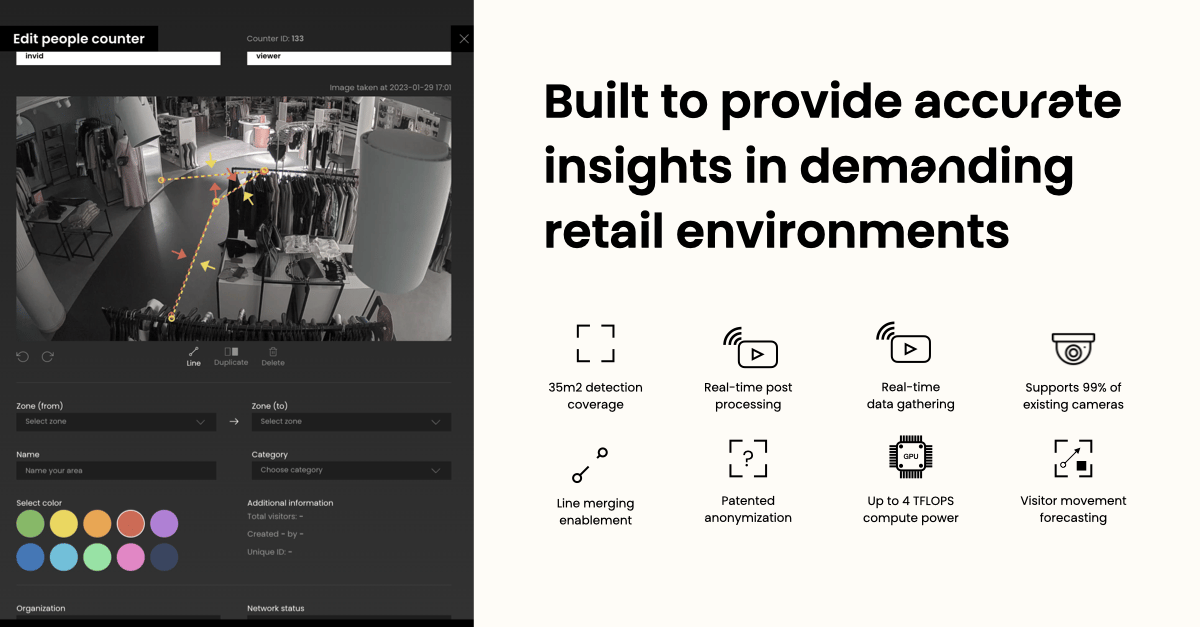Editors pick People Counting 14 Feb 2023
Maximizing Accuracy: Getting the Most Out of Your People Counter
The accuracy of people counters can vary greatly depending on the technology and provider. Some providers claim up to 99% accuracy. However, factors such as poor lighting, crowded spaces, or people carrying large objects impact the accuracy of the count. These factors are more accurately known as noise.
That is why many retailers have bad experiences and people counters need to be built to manage the various situations that arise, and why we have built a more advanced people counter which only had a 3,14% margin of error for 1,3 million people.
This affects people counter accuracy
Several factors can affect the accuracy of people counters. Here are some of the most common ones:
-
Environmental conditions
Poor lighting can affect the performance of some sensing technologies. -
Object size and shape
People counters may have difficulty accurately detecting people who are carrying large objects or are wearing loose-fitting clothing or winter clothing that obscures their shape. Infrared beam counters, for example, may have trouble distinguishing between a person and an object that is roughly the same size and shape. -
Placement of the people counter
Different people counters and various insights have various needs to be able to accurately detect all people entering and exiting the space. -
Type of technology used
Different types of people counters use different sensing technologies, and the accuracy of each may vary.
How is the accuracy of people counting measured?
The accuracy of people counters is typically measured in two ways. Either by manually comparing the number of people detected by the counter to a manual count of the same space, or by comparing the number of visitors entering to the number of people exiting a controlled area over time.
The results of the manual count are then compared to the data generated by the people counter to determine the accuracy of the system. This is often expressed as a percentage or a ratio, such as "98% accurate" or "2% margin of error."
What is the cost of inaccurate people counting?
The cost of inaccurate people counting can be significant, both in terms of lost revenue and increased costs.
-
Misallocation of resources
If foot traffic is underestimated, businesses may not schedule enough staff to handle the crowds, leading to long lines and frustrated customers. Overestimating foot traffic can also result in overstaffing and increased labour costs. -
Lost revenue
If conversion rates are lower than expected, businesses may be missing out on potential sales. Inaccurate people counting can also make it difficult to accurately measure the impact of marketing campaigns or changes to store layout. -
Poor customer experience
Long lines and overcrowding can lead to a poor customer experience, which may result in negative reviews and reduced customer loyalty. -
Inefficient use of space
Inaccurate people counting can make it difficult to optimize the use of space, leading to wasted resources and higher operating costs.
What's the secret to Indivd's accuracy?

The secret to why Indivd reaches high reliability is a mix of many hours learning the various potential issues in stores and malls and building features to overcome them, some of these features are:
-
Optimizing our models
People counting is based on AI models which run on computing power. The bigger and more complex the model is, the better it will be at its job. This is why our earliest model was about 1000x more expensive than it is today but as with all AI projects, the biggest workload is optimizing and trimming it to be more efficient.
This has reduced the problems with various environmental conditions. This is also why our people counting is using 4 TFLOPS of compute power per connected camera which is about 40x more compute power than other people counters. -
Real-time post-processing
Real-time post-processing is used to increase the reliability of detections and movements in noisy environments. -
Visitor movement forecasting
Visitor movement forecasting is used to increase the reliability of visitor detections and visitor movements, especially when there are many visitors. -
Visual editor
Our visual editor uses snapshots from your camera (gathered after closing hours) and enables you to create and manage your data gathering in a super easy way. Our visual editor also enables us to manage all various environmental scenarios. -
Optimal placement mapping
Planning is always helpful to ensure quality beforehand. That is why we help you map out your location and use case to ensure the data gathering is as good as possible. -
Calibrate people counters & Onboarding assistance
We help you calibrate your people counter to ensure they are as good as possible, and we help you map out your location and use case to ensure the data gathering is as good as possible.
Are you interested in trying out the market-leading people counter? Try Indivd for free.




